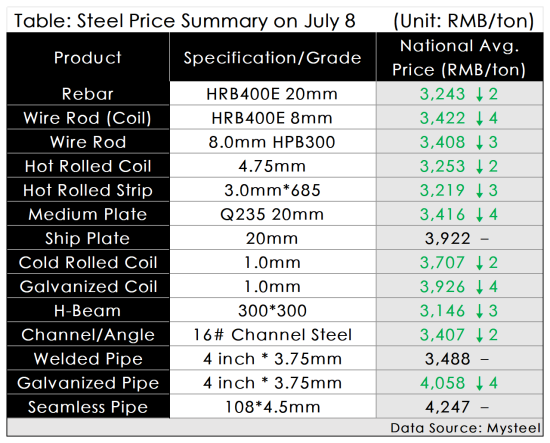【Steel】How Will the Steel Market Evolve Amid Multiple Influencing Factors?

Graphite electrodes are essential in electric arc furnace steelmaking, serving as the core component for arc heating. With excellent conductivity and high-temperature resistance, they play a vital role in ensuring molten steel quality and boosting production efficiency. Controlling graphite electrodes means controlling the key to eaf steelmaking.
【Steel】How Will the Steel Market Evolve Amid Multiple Influencing Factors?
Last week, the Central Financial and Economic Affairs Commission proposed rectifying disordered low-price competition and promoting the orderly exit of outdated production capacity. At the same time, key cities such as Tangshan began implementing July emission reduction measures. With the resonance of multiple news events, black series futures showed a relatively strong and volatile performance, and market sentiment improved. Steel billet prices also rose in tandem. However, as policy expectations gradually cooled and demand remained weak, high-price pressure persisted, and spot prices struggled to follow suit, leading to a slight correction. From both a fundamental and macro perspective, how might the market move next?

Supply: Recently, due to emission reduction measures in Tangshan, several blast furnaces entered maintenance. According to research, 3–4 additional blast furnaces began maintenance during this round, with one resuming production on July 5, while others remain offline. The average daily impact on molten iron output is around 10,800 tons, leading to reduced billet output for some enterprises. However, billet production still retains a certain profit margin, and profits for some finished steel products are weaker than for billets. This profit structure difference has prompted some companies to plan maintenance on rolling lines and increase billet output to optimize production. Meanwhile, billet supply from other regions continues to supplement local availability. Overall, billet supply in Tangshan is expected to remain relatively high in the short term.
Demand: Currently, downstream billet re-rolling enterprises continue to see low profit levels, and some rolling lines remain under maintenance, keeping billet demand low. In the short term, although market sentiment has slightly improved compared to before, terminal demand remains weak, and corporate profit margins are difficult to restore substantively. As a result, billet procurement is expected to remain cautious.
Inventory: Inventory data shows that major storage depots in Tangshan have seen 19 consecutive days of inventory increases. As of publication, the combined inventory of billets at the three major warehouses in Tangshan reached 733,800 tons, up 198,200 tons from the lowest point in the first half of the year. Given the current supply-demand structure and trader sentiment, inventories are likely to continue rising in the short term. Although current inventory levels are still 195,600 tons lower than the same period last year, the ongoing accumulation clearly reflects the weak demand environment and poses potential pressure for the supply chain.
Cost: Recently, molten iron production has slightly declined but remains high year-on-year. Combined with profits staying within a reasonable range, this provides some support for raw material demand. Supply has contracted slightly on a short-term basis, so pressure is relatively limited. In this environment, supply-demand imbalance is minor, and prices are expected to remain relatively stable in the short term. However, in the medium to long term, supply-side pressure persists, with expectations of reduced molten iron production. Prices may trend downward, but this depends on further policy developments.
Sentiment: Overall price valuation has improved from earlier levels, leading to a partial recovery in producer confidence. However, due to persistently weak overall demand and uncertainty around U.S. tariff policy potentially creating new disturbances, the market remains cautious and wary of high prices. That said, current valuations for black series products are relatively low, and short-term bearish momentum is limited. Therefore, the downside for prices appears constrained.
Conclusion: Amid the interplay of policy expectations, supply-demand fundamentals, and external tariff uncertainty, the steel market lacks a clear direction and is expected to continue fluctuating within a narrow range.
Feel free to contact us anytime for more information about the EAF Steel market. Our team is dedicated to providing you with in-depth insights and customized assistance based on your needs. Whether you have questions about product specifications, market trends, or pricing, we are here to help.
No related results found








0 Replies